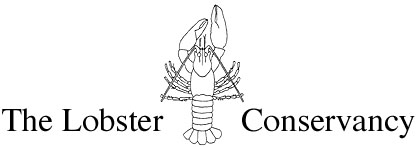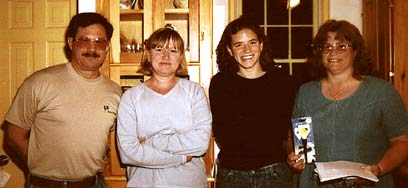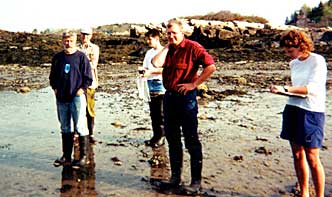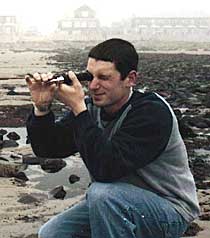
P.O. Box 235, Friendship, ME 04547 (207) 832-8224 www.lobsters.org

P.O. Box 235, Friendship, ME 04547 (207) 832-8224 www.lobsters.org
May 31, 2000
Dear Volunteers and Friends of The Lobster Conservancy,
Welcome back to the field! It's been an exciting month finding the young lobsters returning from their wintering grounds. Many thanks to all of you who have returned and to newcomers joining us for the real Census 2000 — lobsters, that is!
Research News
Volunteer Program
Baby Lobster Watch 2000 is off to a great start. In May, volunteers sampled at 18 sites from Isle au Haut, Maine all the way to Manomet Point, Massachusetts. Thank you to visitors Joanne Coleman and Karen Traverse for taking time out of their visit from Prince Edward Island to construct quadrats in time for the new season. Thanks also to volunteer Pat Seward who has been helping mail out newsletters to all of our volunteers.
In Penobscot Bay, Maine, Greg Kibitz is looking for a new site, after spending last year sampling a lobsterless site in Rockport. In May, Greg checked out Spruce Head Island and Birch Point State Park but didn't find any lobsters. He plans to look again at Birch Point and check out the rocky ends of Crescent Beach next month. Out on Allen Island, Mike Wall found 8 lobsters, ranging is size from 36-55 mm carapace length (CL) in his split transect spanning two 10-meter lengths. Some of the lobsters Mike found were quite beat up, while other looked perfect. It is interesting to note that analysis of Diane's 7-year time series shows that injured lobsters are most prevalent in Spring when juveniles have returned from their wintering grounds, but have not yet molted. The missing limbs will grow back when these lobsters shed their old exoskeletons. At Drift Inn Beach, Jane Roundy and Julie Wortman were disappointed to find only 2 lobsters, but this low abundance was seen at some of the other sites around Pen Bay this month. Leslie Fuller and Ben Neal of the Island Institute and Annette Naegel found no lobsters along their transect at Waterman Beach, but they did find 2 while searching randomly. They are hoping to find a richer location to move their transect to, and may split their transect into two 10-meter sections to avoid inappropriate habitat (i.e., rocks that are cemented into the substrate). On Isle au Haut, Kipp and Trent Quinby found 1 male lobster (41 mm CL) cohabiting with a green crab. On Vinalhaven, John and Ginger Van Ness continued to sample two types of habitat at Lane's Island. They found 3 lobsters (35-48 mm CL) in rocky habitat, and 2 lobsters (62-78 mm CL) in eel grass beds. As they discovered last year, the lobsters living in eelgrass tend to be quite large (for reference, 83 mm CL is the minimum legal size).

Ned and Kathy Osolin (left) hosted a pre-season kick off for other Harpswell volunteers, including Amy Trumbull and Corie Bibber (right). Photo by Sara Ellis
In Harpswell, volunteers attended a pre-season kick off graciously hosted by Kathy and Ned Osolin. Amy Watson found 2 lobsters (36-76 mm CL) along her transect at Cundy's Harbor. But her most exciting moment was when she looked under one irresistible rock and found 6 lobsters living together. They ranged in size from 46 mm CL all the way down to a tiny 6 mm CL (this month's record low). Ned and Kathy Osolin took Amy Trumbull in their inflatable boat to Jaquish Island, where they found 3 lobsters (35-52 mm CL). Corie Bibber sampled both of her sites in Mackerel Cove and Little Harbor.

There is large team of volunteers scouting for lobster nursery grounds on Chebeague Island in Casco Bay. Photo by Diane Cowan
In Western Casco Bay, TLC is coordinating with Friends of Casco Bay (FOCB) to establish new sites, starting with Chebeague Island and Cape Elizabeth. There is a high level of interest on Chebeague Island. On May 7, veteran lobster-seekers Carol White and Anna Maine led Diane Cowan, Bob Putnam, Mac Passano, Beth Howe, Beverly and Stephen Johnson, Darya Johnson, and Carol Lynn Davis to Chandler Cove. Diane trained the team how to monitor lobsters in the intertidal zone and they found 2 lobsters (37-45 mm CL). The next day, Carol, Diane, and Bob went to Bennett Cove for another scouting and training session, this time with Mike Doan, Mary Cerullo, and Meaghan Murphy of FOCB, as well as Erno Bonebakker, James Poell, and Jim Millinger of Chebeague. They found 4 lobsters (32-74 mm CL) while searching randomly and made plans about where to look next. At Cape Elizabeth, Mike Doan, Mary Cerullo, and Meaghan Murphy of FOCB joined Diane again to scout around Kettle Cove and train new volunteer Helen Muther. They found 6 lobsters (18-46 mm CL), mainly in tide pools. Tide pools are more difficult to sample than exposed rocks, since lobsters have a good chance of escaping undetected.

Bryan Watson, an intern at the Wells National Estuarine Research Reserve, was trained to monitor lobsters at Wells Beach. Photo by Sara Ellis
In Southern Maine, Sara met up with Bryan Watson, an intern at the Wells National Estuarine Research Reserve. They were skunked at both Wells Beach and Laudholm Beach, but Bryan picked up the monitoring technique readily and plans to go back in June on more extreme low tides to take another look, and to scout elsewhere if needed. Enid White and Patrice Farrey were also skunked at Lobster Cove in York, but they are bound and determined to keep looking until they hit the mother lode!
In New Hampshire, long-time volunteer Al Stewart trained Timothea Jouse and Julie Ligon to take over the monitoring site at Odiorne Point State Park. Timothea and Julie found 3 lobsters (34-44 mm CL), including a slippery one that got away. Next month, TLC will be scouting for new sites with the assistance of Dr. Win Watson of University of New Hampshire (UNH), and Sara will give presentations at UNH to recruit and train new volunteers (see Upcoming Events, below).
In Massachusetts, Sara went back to Plum Cove, Gloucester, a promising-looking site that lobsterman Peter Prybot had shown us in April. Sara found 2 lobsters there this time (46 and 48 mm CL), and met Patricia Earle who was monitoring salinity at Plum Cove that morning. Pat has offered to start lobster monitoring in Gloucester along with City Councilwoman Astrid af Klinteberg. In Marblehead, Oddvar Solstad, Sean Sullivan, Denny and Peggy Curtin, and Berit Solstad joined Sara at Gerry Island for a training session. This site, which TLC first visited in April with Ellie Tomlinson and Lainie Ives, has turned out to be a very rich nursery ground, with juvenile lobsters under almost every flippable rock. Incoming tide prevented the team from completing a 20-meter transect, but they found 12 lobsters (29-51 mm CL) in as many quadrats. The story wasn't so sweet at TLC's southernmost monitoring site, Manomet Point, where Chad Keith and Heather Sagar struck out. Better luck next time, you two!
Long-term Tagging of Juvenile Lobsters
In May, Diane and Sara traveled in the Awe Spray to their tagging site in Lobster Gut, Deep Cove, Friendship Long Island. Lobster abundance was up from last month (when they found only 1 lobster), as they uncovered and tagged 18 lobsters (19-55 mm CL).
Lowell's Cove continues to be an incredibly rich nursery ground for lobsters. On May 6, Gus Goodwin and Polly "the Lobster Magnet" Wilson helped Diane and Sara sample 3 transects and random areas. They found a record 86 lobsters (16-60 mm CL), as compared with only 2 lobsters last month. Of these 86 lobsters, 5 were recaptures that Diane had tagged previously.
Friendship Lobster Laboratory

TLC scientists can identify individual adult lobsters by scanning pit tags that are injected into a walking leg. Photo by Sara Ellis
The first results are in on our experimental tagging study on adult lobsters that is being funded by the Davis Conservation Foundation. We are testing the efficacy of internal tags called "pit tags." These are individually-coded 5 mm-long wire tags that can be read electronically using a scanning detector. Such tags, designed for implantation in rodents, have been used previously for keeping track of salmon, but have never before been used on lobsters. We wanted to test whether the tags could be scanned through the hard exoskeleton of lobsters and whether they would be retained in the muscle tissue of lobsters over time. Pit tags were donated by the National Marine Fisheries Service, Northeast Fisheries Science Center.
Oversized lobsters were donated by Friendship lobstermen Henry Thompson and Kevin Benner between December 1999 and March 2000. Each lobster was measured, and gender and distinguishing characteristics were recorded. A pit tag was injected into the muscle tissue of the 2nd right walking leg of each lobster using a hypodermic needle. Lobsters were kept in individual cages within the lobster pound and fed periodically with live mussels, crabs, and bait fish. In May, we checked for retention of the tags by scanning each lobster's tagged leg using a Destron Pocket Reader. The results were very encouraging, as we were able to electronically read the tag number in 2 out of 3 lobsters more than 4 months after injection. The next important test of this method will be whether the pit tags stay in the lobsters throughout the molting process.
Recent visitors to the Friendship Lobster Lab include Peter Lawton of the Canadian Department of Fisheries and Oceans along with wife and son, Nancy and Graham. Peter provided information regarding Canada's lobster fishery. After visiting the lab for the first time, Althea Alexander of Orr's Island decided to donate Gene's last lobster boat, Capn Zack, to the Friendship Lobster Lab. Many thanks, Althea!
Outreach and Education
Bowdoin College student Amy Trumbull has finished her mapping project for TLC. The final product of her work consists of prototype GIS maps of the transect locations at 5 monitoring sites in Harpswell. Thanks go to Corie Bibber, Amy Watson, and Ned and Kathy Osolin for taking Amy to their monitoring sites where she collected data on the location of their transects using a differential GPS. In the future, it will be possible for other students and researchers to add layers of information to these maps that could include data, graphs, and photographs.
In May, both Diane and Sara gave talks in public schools. Diane visited Jackie Aussicker's 2nd grade class at the Indian Fields Elementary School, Dayton NJ, and talked about the "Lobster Life Cycle: from Egg to Plate." Sara gave presentations on Careers in Marine Biology to 5 sets of 7th graders at the Lewiston Middle School, as part of the "Building a Future Program" of the "Lewiston Aspirations Partnership."
On May 16, Diane spoke to this year's class of Penobscot Bay Marine Stewards about Intertidal Ecology. After her talk, they all went out to Moose Point State Park at low tide to search for intertidal critters.
To spread the word about TLC's volunteer program in Massachusetts and recruit local volunteers, Sara gave a presentation on lobster biology and research in Marblehead. Thanks go to the Shore Lea Nature Center for sponsoring the presentation, and to Island Institute for loaning an overhead projector. Thanks also to Salem resident Jeanne Rankin of the New England Aquarium for hosting Sara's visit. On May 25th, Diane and Sara attended a public symposium hosted by Salem Sound 2000 entitled the "State of the Sound: Current Knowledge and Future Directions." Diane participated in the panel discussion focusing on future research needs for monitoring biological, chemical, and physical factors within Salem Sound.
Upcoming Events
Mark your calendars! The Lobster Conservancy will be hosting a Volunteer Appreciation Day on Saturday August 19th (with Sunday August 20th as a rain date) at the Friendship Lobster Laboratory. We plan to have a big feast to thank volunteers, past and present, for the many hours they have put towards data collection and other tasks at The Lobster Conservancy.
In early June, Sara will be giving presentations in New Hampshire on the Baby Lobster Watch, sponsored by the Greater Piscataqua Community Foundation. On June 6, Sara will speak at the monthly meeting of UNH Marine Docents, 10:30-11:30 am in the 1925 Room, Elliott Alumni Center, UNH. She will lead a hands-on training session the next morning (Wednesday June 7) from 8:30-11:00 am, for people interested in monitoring intertidal lobster nursery grounds in New Hampshire or Southern Maine. On the evening of June 7, Sara will speak at the monthly meeting of the Great Bay Coast Watch, which will be held from 7:00-8:30 pm at Kingman Farm, Route 155, Madbury. These meetings are open to the public, so come one and all. For directions, please contact UNH Sea Grant at (603) 749-1565.
And on a final note, we have good news for those of you who have had trouble lately communicating by e-mail with Diane. Diane's ability to connect to the internet from Friendship Long Island has improved dramatically since we switched to local Internet Service Provider, Midcoast Internet. So feel free to start bombarding again her with messages at dcowan@lobsters.org.
Yours in TLC and Friendship,
Sara Ellis, Executive Director and Diane Cowan, Senior Scientist